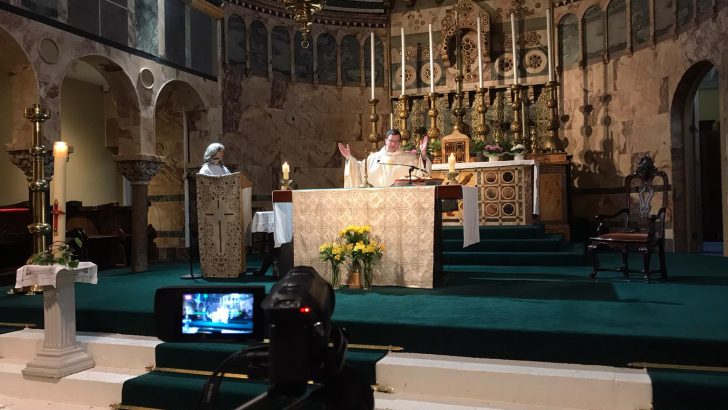As parishes begin to re-open for public Masses the virtual space is here to stay, writes Michael Kelly
While Cardinal John Henry Newman’s vision of a Catholic university in Dublin ultimately floundered, the church he built in the city centre remains a jewel in Ireland’s ecclesiastical map.
Consecrated in 1856, it has remained an important place of worship in the capital ever since. Like other churches the parish faced a massive challenge as lockdown began in March. For the past four years, the church has been stewarded by the University of Note Dame which uses the site on St Stephen’s Green as a base for the Notre Dame-Newman Centre for Faith and Reason.
As coronavirus restrictions took hold, the decision was quickly made to migrate public worship to social media according to Steve Warner, Associate Director of the centre.
Almost three months on, he told The Irish Catholic that “when all of this started, my hope was that we’d come out of this on the other end with something to show for it”.
Volunteers
Broadcasting liturgies and other events had not been something that the centre had given serious thought to before the pandemic.
“We had already started broadcasting out weekly Taizé [on a Tuesday evening],” says Katherine Dunn one of the House of Brigid volunteers who ministers at the church.
“It was only Facebook live, and somewhat of an afterthought – but because we had started that it was helpful when all of this happened because we knew the basic things and could build on that,” she adds.
The centre also started from a good place because it already had a Facebook page with a substantial number of followers both in Ireland and the US.
“There are many people who are associated with the University of Notre Dame who are keenly interested in what we’re doing over here and follow us quite closely, so we were getting comments and views on our liturgies from all over the US as well as Ireland,” says Steve.
Like many parishes moving online has been a steep learning curve for University Church. For Maddie Loftin, another volunteer at the House of Brigid, these are lessons that will remain. “It has been a transition,” she says, “but one that will be part of the future”.
Steve says that the few dozen people who had been watching Taizé before the lockdown meant that there was already a familiarity with the church as a virtual place of worship.
Katherine says that the virtual congregation is made up of people who used to worship at the church as well as others who attended events there before lockdown. “We see an increase because we can see that people are sharing the broadcasts and sending one another the links,” she says.
Steve believes that the huge numbers of people who have been tuning in to watch online Masses ‘underlines the spiritual hunger of people’”
While there is overwhelming joy at the prospect of public Masses returning at the end of the month, the reality is that some people – particularly those who are older or vulnerable – will continue to avoid public gatherings for quite some time.
This is part of the reason why University Church is determined that the virtual reach will continue.
“Once we’re back to whatever normal is going to be, we’re still going to have this request to have things offered on the internet for people who can’t travel for any number of reasons,” Steve says.
Maddie agrees adding “there’s an impetus there for us to push ourselves to continue using the equipment now that we have built it up”.
Steve believes that the huge numbers of people who have been tuning in to watch online Masses “underlines the spiritual hunger of people”.
In recent years, University Church has become particularly known as a centre for good preaching and quality music. Steve says that he gets huge reaction to the homilies of the resident priest Fr Bill Dailey CSC as well as to the music – his own speciality. But, was he concerned that with lockdown restrictions and the unavailability of musicians and choir members that this would suffer? “I wasn’t afraid at all about pairing down musically so long as it had noble integrity to it and I think that we’ve been able to do that, so we planned on a repertoire that embraced the sparseness”.
There has been a fair share of trial and error in getting the technical side of the broadcasting right”
Fr Bill like other priests has also had to get used to preaching to an empty church. “It’s obviously tougher to engage with people,” he says. “But the feedback I have been getting is hugely positive from people, so I think we’re still communicating the message virtually,” he adds.
Katherine says that there has been a fair share of trial and error in getting the technical side of the broadcasting right, but she is adamant that parishes should stick with it when lockdown eases. “It’s totally worth it,” she says. “It is an added dimension to the liturgy and it means that we can continue to reach people we can’t reach physically”.
What has been your parish’s experience of liturgy under lockdown? Email news@irishcatholic.ie


 Michael Kelly
Michael Kelly Katherine Dunn and Maddie Loftin are at the controls as Fr Bill Dailey CSC celebrates Mass and Michele Warner looks on
Katherine Dunn and Maddie Loftin are at the controls as Fr Bill Dailey CSC celebrates Mass and Michele Warner looks on 